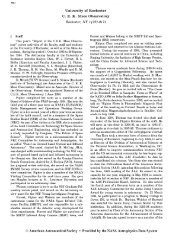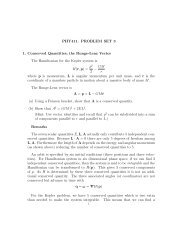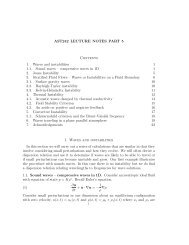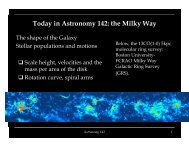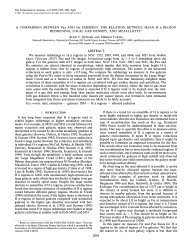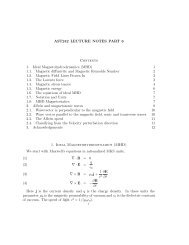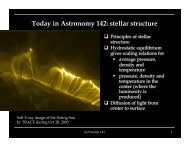Today in Astronomy 142: observations of stars - Astro Pas Rochester
Today in Astronomy 142: observations of stars - Astro Pas Rochester
Today in Astronomy 142: observations of stars - Astro Pas Rochester
- No tags were found...
Create successful ePaper yourself
Turn your PDF publications into a flip-book with our unique Google optimized e-Paper software.
<strong>Today</strong> <strong>in</strong> <strong><strong>Astro</strong>nomy</strong> <strong>142</strong>: <strong>observations</strong> <strong>of</strong> <strong>stars</strong>What do we know about <strong>in</strong>dividual<strong>stars</strong>?! Determ<strong>in</strong>ation <strong>of</strong> stellarlum<strong>in</strong>osity from measured fluxand distance• Magnitudes! Determ<strong>in</strong>ation <strong>of</strong> stellar surfacetemperature from measurement<strong>of</strong> spectrum or color• Blackbody radiation• Bolometric correctionAt right: the old open cluster M29(2MASS/IPAC).<strong><strong>Astro</strong>nomy</strong> <strong>142</strong> 1
JanuaryviewpJulyviewStarrTrigonometric parallaxRelatively nearby <strong>stars</strong> appear tomove back and forth with respectto much more distant <strong>stars</strong> as theEarth travels <strong>in</strong> its orbit.S<strong>in</strong>ce the size <strong>of</strong> the Earth’s orbit isknown very accurately from radarmeasurements, measurement <strong>of</strong>the parallax p determ<strong>in</strong>es thedistance to the star, precisely andaccurately.EarthAUp is an angle5
Parallax (cont<strong>in</strong>ued)S<strong>in</strong>ce the Earth’s orbitis (nearly) circular,parallax can bemeasured no matterwhat the direction tothe star.6
Trigonometric parallax (cont<strong>in</strong>ued)Mean distance between centers <strong>of</strong> Earth and Sun:Thussmall angleapproximationwhere the parallax p is measured <strong>in</strong> radians.! Parallax is usually expressed <strong>in</strong> fractions <strong>of</strong> an arcsecond(π radians = 180 degrees = 10800 arcm<strong>in</strong>utes = 648000arcseconds); the distance to an object with a parallax <strong>of</strong> 1arcsecond, called a parsec, is! Good parallax measurements: about 0.02 arcsec from theground, ~ 0.001 arcsec from the Hipparcos satellite.7
Parallax examplesWhat is the largest distance that can be measured by parallaxwith ground-based telescopes? With the Hipparcos satellite?First note that we can write the distance-parallax relation asr = 1 parsec ⇥✓ ◆ arcsec! If the smallest parallax we can measure is 0.01 arcsec, thelargest distance measurable is 1/0.01 = 100 parsecs.! Similarly, Hipparcos got out to 1/0.001 = 1000 parsecs.! The ESA satellite Gaia, launched last year, will measureparallax with an accuracy <strong>of</strong> 0.00002 arcsec, thus perhapsstretch<strong>in</strong>g out to 50 000 parsecs = 50 kpc.• Compare: we live 8 kpc from the center <strong>of</strong> our Galaxy.p8
Parallax examples (cont<strong>in</strong>ued)If we lived on Mars, what would be the numerical value <strong>of</strong>the parsec?Mars’s orbital semimajor axis is 1.524 AU, so the “parsec” is afactor <strong>of</strong> about 1.524 larger:But Mars’s orbit is twice as eccentric as Earth’s, so those lastdecimal places are affected by the orbit.9
Thethirtynearest<strong>stars</strong>Figure:ChaissonandMcMillan,<strong><strong>Astro</strong>nomy</strong><strong>Today</strong>10
<strong>Astro</strong>nomer units: magnitudesAncient Greek system: first magnitude (and less) are thebrightest <strong>stars</strong>, sixth magnitude are the fa<strong>in</strong>test the eye cansee.The eye is approximately logarithmic <strong>in</strong> its response:perceived brightness is proportional to the logarithm <strong>of</strong> flux.To match up with the Greek scale,or, for two <strong>stars</strong> with apparent magnitudes m 1 and m 2 ,11
Magnitudes (cont<strong>in</strong>ued)magnitude = -2.5 log 10 (flux) + constantLogarithmic scale <strong>of</strong>ten used formeasurements based on human perception• Decibels <strong>in</strong> audio (not <strong>in</strong>verted10 log 10 power)• Richter scale for earthquakes(not <strong>in</strong>verted)12
Magnitudes cont<strong>in</strong>uedBrightnessMagnitude! Magnitudes are dimensionless: they are related to ratios<strong>of</strong> fluxes or distances.! Another legacy from the Greeks: magnitudes runbackwards from the <strong>in</strong>tuitive sense <strong>of</strong> brightness.• Brighter objects have smaller magnitudes. Fa<strong>in</strong>terobjects have larger magnitudes. They’re like “rank.”! Fluxes from a comb<strong>in</strong>ation <strong>of</strong> objects measured all atonce add up algebraically as usual. The magnitudes <strong>of</strong>comb<strong>in</strong>ations <strong>of</strong> objects do not.! Calibration is done through comparisons13
Magnitudes -the reference or zero po<strong>in</strong>tA practical def<strong>in</strong>ition <strong>of</strong> zero apparent magnitude is Vega(α Lyrae), which has m = 0 at nearly all wavelengths (lessthan 20 microns).Absolute magnitude is the apparent magnitude a starwould have if were placed 10 parsecs away.An A0 star at 10 pc has magnitude zero <strong>in</strong> all bandsBolometric magnitude is magnitude calculated from theflux from all wavelengths, rather than from a small range<strong>of</strong> wavelengths.In this week’s workshop you’ll show that the absolute andapparent bolometric magnitudes, M and m, <strong>of</strong> a star arerelated by:14
Magnitudes – zero po<strong>in</strong>tmagnitude = -2.5 log 10 (flux) + constantmagnitude = -2.5 log 10 (flux/flux_comp)constant = 2.5 log 10 (flux_comp)flux_comp is the flux that gives youzero magnitudewe call the constant the zero po<strong>in</strong>t andis related to the flux that gives you zeromagnitude15
Magnitudes (cont<strong>in</strong>ued)Example (IAA problem 11.2). Two <strong>stars</strong>, with apparentmagnitudes 3 and 4, are so close together that they appearthrough our telescope as a s<strong>in</strong>gle star. What is the apparentmagnitude <strong>of</strong> the comb<strong>in</strong>ation?16
Magnitudes (cont<strong>in</strong>ued)Example (IAA problem 11.2). Two <strong>stars</strong>, with apparentmagnitudes 3 and 4, are so close together that they appearthrough our telescope as a s<strong>in</strong>gle star. What is the apparentmagnitude <strong>of</strong> the comb<strong>in</strong>ation?Call the <strong>stars</strong> A and B, and the comb<strong>in</strong>ation C:First how much larger flux does A have than B?Add 1 to both sides:So17
Magnitudes and PhotometriccalibrationObserve an object at the same time as anotherobject with known brightness (two <strong>stars</strong> <strong>in</strong> thesame field <strong>of</strong> view).F<strong>in</strong>d correction factor for known objectUse that correction factor to measure apparentmagnitude <strong>of</strong> your object.Apparent magnitude – how bright the object isobserved to be.18
Absolute magnitudeIf you know the distance to the object and youmeasure the apparent magnitude, then you candeterm<strong>in</strong>e the brightness for the object as if wereobserved at 10pc away.This is the absolute magnitude.Directly related to the <strong>stars</strong> <strong>in</strong>tr<strong>in</strong>sic lum<strong>in</strong>osityWays to know distances?19
Blackbody emissionBecause <strong>stars</strong> are opaque at essentially all wavelengths <strong>of</strong>light, they emit light much like ideal blackbodies do.Blackbody radiation from a perfect absorber/emitter isdescribed by the Planck function:B (T )= 2hc251e hc/ kT 1Power per unit area,bandwidth and solid angle.B λ units: erg s -1 cm -2 wavelength -1 sterradian -1For a small bandwidth (wavelength <strong>in</strong>terval) Δλ (
Blackbody emission (cont<strong>in</strong>ued)Surface brightness, relative to the Sun’speak surface brightness30000 K10000 K3000 KWavelength (µm)Although <strong>stars</strong> likethe Sun are brightestat visible wavelengths,the Planckfunction for star-liketemperatures is muchwider than the visiblespectrum.So most <strong>of</strong> a star’slum<strong>in</strong>osity comes outat ultraviolet and/or<strong>in</strong>frared wavelengths.21
Planck function30000 K10000 K3000 KB ⌫ (⌫) B ( )As a function <strong>of</strong>photon frequencyWavelength (µm)As a function <strong>of</strong> photonwavelength22
Blackbody emission (cont<strong>in</strong>ued)B ⌫ (⌫)B ( )flux <strong>in</strong>tegrated between ν and ν + dνflux <strong>in</strong>tegrated between λ and λ+ dλ⌫ = c/B ⌫ (⌫)d⌫ = B ( )d<strong><strong>Astro</strong>nomy</strong> <strong>142</strong> 23
Color and temperatureNote that a givenratio <strong>of</strong> flux with<strong>in</strong>the B and Vwavelength ranges(see below) ischaracteristic <strong>of</strong> acerta<strong>in</strong> temperature<strong>of</strong> blackbody, andthat cont<strong>in</strong>uousstellar spectra areapproximatelyblackbodies.Figure: Chaisson andMcMillan, <strong><strong>Astro</strong>nomy</strong> <strong>Today</strong>24
Planck functionB (T )= 2hc251e hc/ kT 1h Planck’s constantk Boltzmann’s constantc speed <strong>of</strong> lightphoton energy distributionPhotons <strong>in</strong> a box derivationEnergy levels set with Planck’s constantEnergy levels populated proportional to exp(E/kT)<strong><strong>Astro</strong>nomy</strong> <strong>142</strong> 25
Integrat<strong>in</strong>g the Planck functionB (T )= 2hc251e hc/ kT 1k Boltzmann constanth Planck constantZ 10B (T )d = 2k4 ⇡ 415h 3 c 2 T 4= B T 4⇡us<strong>in</strong>gZ 10x =x 5e 1/xkThc⇡4dx =1 15σ B = 5.67 x 10 -5 erg cm -2 s -1 K -4is the Stefan-Boltzmannconstant.B = 2⇡5 k 415h 3 c 2<strong><strong>Astro</strong>nomy</strong> <strong>142</strong> 26
Blackbody emission (cont<strong>in</strong>ued)The total flux emitted <strong>in</strong>to all directions at all wavelengthsfrom the surface <strong>of</strong> a blackbody isf =f =Z 10Z 10df = B T 4⇡ZZd B (T )2⇡2⇡d⌦ cos ✓B (T )Z ⇡/2cos ✓ s<strong>in</strong> ✓d✓ hemisphereL =4⇡R 2 BT 40cos ✓ s<strong>in</strong> ✓d✓ = B T 4Z ⇡/20σ B = 5.67 x 10 -5 erg cm -2 s -1 K -4 is the Stefan-Boltzmannconstant.Lum<strong>in</strong>osity <strong>of</strong> a spherical blackbody with radius R:27
Blackbody emission (cont<strong>in</strong>ued)Wavelength <strong>of</strong> the Planck function’s maximum value changeswith temperature accord<strong>in</strong>g toRem<strong>in</strong>ders about solid angle:! Solid angle for cone with smallapex angle θ is! Differential element <strong>of</strong> solid angle <strong>in</strong> sphericalcoord<strong>in</strong>ates:✓ 2 [0, ⇡]28
Solid angles29
S λ Ω ⊙ or B λ Ω ⊙Stars are blackbodies to (pretty good)approximation.Solar flux perunit band-widthas seen fromEarth’s orbit,com-pared to theflux per unitbandwidth <strong>of</strong> a5777 K blackbodywith the sametotal flux.(WikimediaCommons)30
Effective TemperatureL =4⇡R 2 BT 4for a black bodyT e is the temperature <strong>of</strong> the blackbody <strong>of</strong> the samesize as a star (not exactly a black body), that givesthe same lum<strong>in</strong>osity:T e =✓L4⇡R 2B◆ 14The Sun’s lum<strong>in</strong>osity and radius gives aneffective temperatureBlackbody: surface brightness and spectrumdescribed by 1 parameter, the temperature31
Color and temperature (cont<strong>in</strong>ued)ρ Ophiuchi. a molecular cloud at T =60 K.A young stellar object. The star'ssurround<strong>in</strong>gs have T = 600 K.The Sun's surface, T = 6000 K.Evolved <strong>stars</strong> <strong>in</strong> ω Centauri, at T =60,000 K.Figure: Chaisson and McMillan,<strong><strong>Astro</strong>nomy</strong> <strong>Today</strong>.32
Stellar photometryTo facilitate comparison <strong>of</strong> measurements by differentworkers, astronomers have def<strong>in</strong>ed standard bands, eachdef<strong>in</strong>ed by a center wavelength and a bandwidth, forobserv<strong>in</strong>g <strong>stars</strong>.! At visible wavelengths the bands <strong>in</strong> most common use(Johnson 1966) are as follows:BandWavelength (nm) Bandwidth (nm)U 360 70B 430 100V 540 90R 700 220! Measurement <strong>of</strong> starlight flux (or magnitudes) with<strong>in</strong>such bands is called photometry.33
Color and effective temperatureColor is the difference between apparent magnitude atdifferent wavelengths, or 2.5 times the logarithm <strong>of</strong> the ratio<strong>of</strong> fluxes <strong>in</strong> the two bands.Color <strong>in</strong>dex: the color between the B and V bands:In the absence <strong>of</strong> ext<strong>in</strong>ction, color is an <strong>in</strong>dex <strong>of</strong> the effectivetemperature T e <strong>of</strong> <strong>stars</strong>.For T e < 12000 K, and tak<strong>in</strong>g B = V = 0 at T e =10000 K (likeVega),relat<strong>in</strong>g color totemperature34
Color and effective temperature (cont<strong>in</strong>ued)Surface brightness, relative to the Sun’speak surface brightness30000 K10000 K3000 KBVExample: for thesespectra, the visiblecolors aretop to bottom.Wavelength (µm)35
Color and effective temperature (cont<strong>in</strong>ued)Surface brightness, relative to the Sun’speak surface brightness30000 K10000 K3000 KBVAt 30000 K most <strong>of</strong>the radiation isemitted bluer thanvisible wavelengthsAt 3000K most <strong>of</strong> theradiation is emittedredder than visiblewavelengthsWavelength (µm)36
Color <strong>in</strong>dex and effective temperature(Johnson 1966)37
Color, magnitude and bolometric correctionOnce the shape <strong>of</strong> a star’s spectrum (i.e. its temperature) isdeterm<strong>in</strong>ed from its colors, the total flux is also determ<strong>in</strong>ed.! In magnitude terms: the ratio <strong>of</strong> total flux to flux with<strong>in</strong>one <strong>of</strong> the photometric bands is expressed as a bolometriccorrection to the star’s magnitude <strong>in</strong> that band, usually V:! In blackbody terms: once the temperature <strong>of</strong> the body isknown, so is the total flux . If stellar spectrawere really blackbodies, the bolometric correction wouldbe38
Bolometric correction, BCBolometric correctionfor ma<strong>in</strong> sequence<strong>stars</strong> (Johnson 1966)Bolometric correction(cont<strong>in</strong>ued)Shape <strong>of</strong> spectrum, and thiscorrection factor, can bedeterm<strong>in</strong>ed if one knows thecolor <strong>of</strong> the star (differencebetween apparentmagnitudes at twowavelengths).Scal<strong>in</strong>g factor for flux is thesame as an <strong>of</strong>fset <strong>in</strong>magnitude. This <strong>of</strong>fset iscalled the bolometriccorrection, BC, and isdeterm<strong>in</strong>ed from observed ortheoretical stellar spectra.39
Bolometric correction (cont<strong>in</strong>ued)Example. Two <strong>stars</strong> are observed to have the same apparentmagnitude, 2, <strong>in</strong> the V band. One <strong>of</strong> them has color <strong>in</strong>dex B-V= 0, and the other has B-V = 1. What are their apparentbolometric magnitudes?From the graph, BC = -0.4 and –0.38 <strong>in</strong> these two cases, sotheir bolometric magnitudes are practically the same, too, 1.6and 1.62.! That these magnitudes are both less than the apparent Vmagnitude is a sign that these <strong>stars</strong> produce substantialpower at wavelengths far outside the V band. The bluerstar (with B-V = 0) turns out to be brightest at ultravioletwavelengths; the other one is brightest at red and <strong>in</strong>fraredwavelengths.40
Are perfect Black Body’s ever observed?Not really: In <strong>stars</strong> there are absorption l<strong>in</strong>esand emission l<strong>in</strong>es, absorption edges, morethan one temperature is seen from differentplaces. Many objects emit thermally as wellas non-thermally.Cosmic Microwave Background spectrum isa counter example. It’s really very close to aBlack Body.The frequency spectrum <strong>of</strong> the cosmicmicrowave background records <strong>in</strong>teractionsbetween the evolv<strong>in</strong>g matter and radiationfields. Observations from ground-based,balloon-borne, and satellite <strong>in</strong>strumentsshow the CMB to agree with a blackbodyspectrum (dotted l<strong>in</strong>e) across 3 decades <strong>of</strong>frequency and 4 orders <strong>of</strong> magnitude <strong>in</strong><strong>in</strong>tensity. This agreement with a blackbodyspectrum <strong>in</strong>dicates that the early universewas once <strong>in</strong> thermodynamic equilibrium,and limits energetic events s<strong>in</strong>ce the BigBang: the cosmic microwave backgroundaccounts for more than 99.993% <strong>of</strong> theradiant energy <strong>in</strong> the universe.Credit Cobe team41
Wavelength vs TemperatureFor Black Body’s the wavelength <strong>of</strong> the emission peak is setby the temperature.There is little emission at vastly different other wavelengths.So you can <strong>of</strong>ten estimate the temperature <strong>of</strong> a thermal objectfrom what wavelength (or frequency) you observe it at.• 10 6 K stuff (plasma) emits <strong>in</strong> X-rays. Detected byCHANDRA• 10 4 K stuff (plasma) emits <strong>in</strong> UV. Detected by HST, IUE,FUSE• 10 3 K objects emit <strong>in</strong> optical. By eye.• 10 2 K stuff (cold gas and dust) emits <strong>in</strong> mi-far <strong>in</strong>frared.Detected by SIRTF/SST (previously ISO and IRAS).Note: there is also non-thermal emission -- then this ruledoesn’t apply (e.g. synchrotron emission)42
Near -Infrared Broad Band FiltersAtmospheric absorption along with filter transmissionJHKLMFrom Simmons and Tokunaga et al 200143
Some practical <strong><strong>Astro</strong>nomy</strong>! RA (right ascension) tells you when your object is up.• 12 hours is up highest Mar 21• 0 hours is up highest Sept 21! DEC (decl<strong>in</strong>ation) tells you how far away from the north pole.Polaris is at +90. Anyth<strong>in</strong>g below 0 degrees is hard to observe from thenorthern hemisphere.! Spectral types and lum<strong>in</strong>osity class: A5 VA5 is the spectral typeV is the lum<strong>in</strong>osity class.• V is called a dwarf, also is on the ma<strong>in</strong> sequence. Late type <strong>stars</strong> arefa<strong>in</strong>ter than the Sun, early type are much brighter than the Sun. Range <strong>in</strong>lum<strong>in</strong>osities is about 10 5 , even though the range <strong>in</strong> mass is only 0.1 to100M⊙.• III’s are giants, typically 10 3 times more lum<strong>in</strong>ous than the Sun• I’s are supergiants, typically 10 5 times more lum<strong>in</strong>ous than the Sun.44
Practical astronomy (cont<strong>in</strong>ued)• Us<strong>in</strong>g parallax to estimate distance:The distance <strong>in</strong> parsecs is 1/(parallax <strong>in</strong> arcsecs).• Estimat<strong>in</strong>g the absolute magnitude. The distance modulus is• X-ray emission from <strong>stars</strong> is <strong>of</strong>ten not from the stellar photosphere,(<strong>of</strong> order 5000K) but from the corona (<strong>of</strong> order a million K)• Far <strong>in</strong>frared emission from <strong>stars</strong> is <strong>of</strong>ten not from the stellarphotosphere but from circum-planetary dust that absorbs light fromthe star and reradiates it at longer wavelengths (<strong>of</strong> order 100K).45
Practical astronomy (cont<strong>in</strong>ued)Spectral types: O,B,A,F,G,K,MClassified based on what their spectrum looks like.Is also a temperature scale.Is also a mass scale --- on the ma<strong>in</strong> sequence.M-<strong>stars</strong> are cool and low mass ~0.1 M ⊙ and fa<strong>in</strong>t (0.01 L ⊙ ).O <strong>stars</strong> are very very hot and more massive ~10M ⊙ andbright (10 4 L ⊙ ).Beta Pictorus (A5V) is more massive and lum<strong>in</strong>ous than thesun (a G star)Epsilon Eridani (K2V) is less massive and less lum<strong>in</strong>ous thanthe sun.46
Practical <strong><strong>Astro</strong>nomy</strong> (cont<strong>in</strong>ued)Figur<strong>in</strong>g out how bright th<strong>in</strong>gs are <strong>in</strong> solar lum<strong>in</strong>osities.• Figure out how bright the object is <strong>in</strong>tr<strong>in</strong>sically.• Divide this lum<strong>in</strong>osity by the lum<strong>in</strong>osity <strong>of</strong> the Sun.Equivalently:• Take the absolute magnitude <strong>of</strong> the object, subtract theabsolute magnitude <strong>of</strong> the sun at the same band.• Convert magnitudes <strong>in</strong>to lum<strong>in</strong>osity.Example: A star has an absolute magnitude <strong>in</strong> V band <strong>of</strong> 7.0The sun has an absolute magnitude <strong>in</strong> V band <strong>of</strong> 4.8The star is about 1/10 th as bright as the sun. To do better than this usebolometric corrections.47
Summary! Magnitudes and how to calculate with them! Black body function! The relation between measured color and estimatedtemperature.! Bolometric correction! Broad band photometric measurements.48




